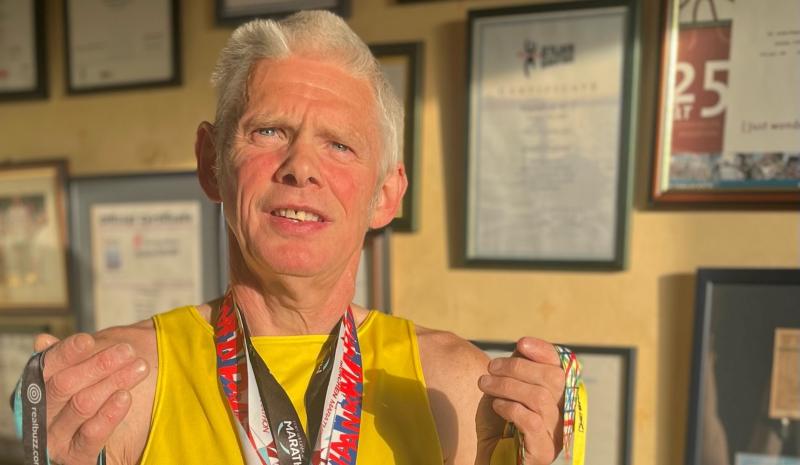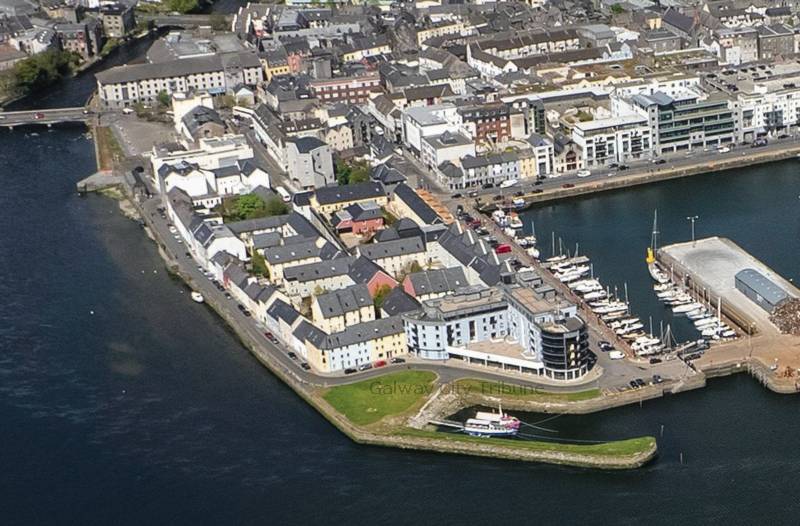News
Dealing with cancer’s aftershock

When Karen Brennan was treated for cervical cancer eleven years ago, she had no idea it would lead to a different but no less debilitating condition affecting her legs, groin and abdomen.
The Barna woman who is a senior manager in Boston Scientific was diagnosed with cancer in September 2004. A year later she underwent surgery and was discharged three weeks later. However after six months she was referred back to her surgeon, complaining of abdominal pain and discomfort with slight swelling in the groin.
She was told the problem was down to scar tissue healing.
By 2009 the problem had quite literally ballooned – her leg had swollen to such an extent she had difficulty removing jeans. She was taken into University Hospital Galway where she underwent a series of tests. She was finally diagnosed two months later with Lymphoedema.
The condition occurs when the lymphatic system fails to function causing persistent swelling and it can affect any part of the body. People can be born with lymphoedema or develop it because the lymphatic system has been damaged. Approximately 15,000 people in Ireland are estimated to have Lymphoedema, with over 1,200 developing it each year following cancer treatment.
Karen was given physiotherapy for the condition in Galway which involves manually draining the build-up of fluid. But she came down with serious leg infections and was referred to the Földi Clinic in Germany, a specialist clinic for lymphology.
She is currently on daily antibiotics to manage the condition. Her husband was trained by the German clinic to carry out the manual lymphatic drainage.
“He does twenty minutes and I do the rest, it can take up to two hours. I apply nine bandages every night and put my right leg on eight pieces of foam to drain it for the next day.
“If I do that every day I can manage it. If not I can develop cellulitis where the limb swells up, get very hard and is extremely painful,” Karen explains.
“It’s a nightmare. It’s called cancer’s aftershock. I keep myself very physically active. I do everything in my power to manage the condition.”
The bandages alone cost €2,500 per year while maintenance Földi treatments cost a further €3,000, which she must bear herself. She has health insurance through work which covers one third of the costs.
The support group Lymphoedema Ireland has designated March Lymphoedema Awareness month.
“A lot of people out there don’t know they have Lymphoedema, they are isolated, get little or no support, they may only get to see a physio once every six weeks which doesn’t help when they need treatment every day,” explains a spokesperson.
“There are no definitive pathways to treatment, it can take ages to get diagnosed, some people get referred to a cancer specialist, others a physio, some patients are sent to a vascular person. There aren’t enough people trained in Ireland to diagnose or treat this really debilitating condition.
“More and more cases are presenting because cancer outcomes are so good. You think it’s fantastic the cancer didn’t get you but it leaves you with this debilitating condition for life.”
A HSE review last year of Lymphoedema services throughout Ireland has yet to be published.
There is no cure for Lymphoedema. However, if diagnosed and treated early by an experienced specialist, the extreme swelling can be controlled and reduced, infection prevented and the range of movement of the affected area can be improved to limit the extent of the disorder and its impact on everyday life.
Professor of Vascular Disease Mary Paula Colgan said a delay in diagnosis and treatment leads to an increase in the incidence of complications including recurrent cellulitis, immobility and ulceration.
“We have excellent Lymphoedema therapists in Ireland in both the public and private sectors. As a clinician my greatest difficulty is accessing these services for patients as several areas of the country provide no services at all, while in other areas many of these services are unavailable for non-cancer patients.”
For more information see www.lymphireland.com or email info@lymphireland.com
Connacht Tribune
West has lower cancer survival rates than rest

Significant state investment is required to address ‘shocking’ inequalities that leave cancer patients in the West at greater risk of succumbing to the disease.
A meeting of Regional Health Forum West heard that survival rates for breast, lung and colorectal cancers than the national average, and with the most deprived quintile of the population, the West’s residents faced poorer outcomes from a cancer diagnosis.
For breast cancer patients, the five-year survival rate was 80% in the West versus 85% nationally; for lung cancer patients it was 16.7% in the west against a 19.5% national survival rate; and in the West’s colorectal cancer patients, there was a 62.6% survival rate where the national average was 63.1%.
These startling statistics were provided in answer to a question from Ballinasloe-based Cllr Evelyn Parsons (Ind) who said it was yet another reminder that cancer treatment infrastructure in the West was in dire need of improvement.
“The situation is pretty stark. In the Western Regional Health Forum area, we have the highest incidence of deprivation and the highest health inequalities because of that – we have the highest incidences of cancer nationally because of that,” said Cllr Parsons, who is also a general practitioner.
In details provided by CEO of Saolta Health Care Group, which operates Galway’s hospitals, it was stated that a number of factors were impacting on patient outcomes.
Get the full story in this week’s Connacht Tribune, on sale in shops now, or you can download the digital edition from www.connachttribune.ie. You can also download our Connacht Tribune App from Apple’s App Store or get the Android Version from Google Play.
Connacht Tribune
Marathon Man plans to call a halt – but not before he hits 160 races

On the eve of completing his 150th marathon, an odyssey that has taken him across 53 countries, Loughrea’s Marathon Man has announced that he is planning to hang up his running shoes.
But not before Jarlath Fitzgerald completes another ten races, making it 160 marathons on the occasion of his 60th birthday.
“I want to draw the line in 2026. I turn 57 in October and when I reach 60 it’s the finishing line. The longer races are taking it out of me. I did 20 miles there two weeks ago and didn’t feel good. It’s getting harder,” he reveals.
“I’ve arthritis in both hips and there’s wear and tear in the knees.”
We speak as he is about to head out for a run before his shift in Supervalu Loughrea. Despite his physical complaints, he still clocks up 30 miles every second week and generally runs four days a week.
Jarlath receives injections to his left hip to keep the pain at bay while running on the road.
To give his joints a break, during the winter he runs cross country and often does a five-mile trek around Kylebrack Wood.
He is planning on running his 150th marathon in Cork on June 4, where a group of 20 made up of work colleagues, friends and running mates from Loughrea Athletics Club will join him.
Some are doing the 10k, others are doing the half marathon, but all will be there on the finishing line to cheer him on in the phenomenal achievement.
Get the full story in this week’s Connacht Tribune, on sale in shops now, or you can download the digital edition from www.connachttribune.ie. You can also download our Connacht Tribune App from Apple’s App Store or get the Android Version from Google Play.
CITY TRIBUNE
Galway ‘masterplan’ needed to tackle housing and transport crises

From the Galway City Tribune – An impassioned plea for a ‘masterplan’ that would guide Galway City into the future has been made in the Dáil. Galway West TD Catherine Connolly stated this week that there needed to be an all-inclusive approach with “vision and leadership” in order to build a sustainable city.
Deputy Connolly spoke at length at the crisis surrounding traffic and housing in Galway city and said that not all of the blame could be laid at the door of the local authority.
She said that her preference would be the provision of light rail as the main form of public transport, but that this would have to be driven by the government.
“I sat on the local council for 17 years and despaired at all of the solutions going down one road, metaphorically and literally. In 2005 we put Park & Ride into the development plan, but that has not been rolled out. A 2016 transport strategy was outdated at the time and still has not been updated.
“Due to the housing crisis in the city, a task force was set up in 2019. Not a single report or analysis has been published on the cause of the crisis,” added Deputy Connolly.
She then referred to a report from the Land Development Agency (LDA) that identified lands suitable for the provision of housing. But she said that two-thirds of these had significant problems and a large portion was in Merlin Park University Hospital which, she said, would never have housing built on it.
In response, Minister Simon Harris spoke of the continuing job investment in the city and also in higher education, which is his portfolio.
But turning his attention to traffic congestion, he accepted that there were “real issues” when it came to transport, mobility and accessibility around Galway.
“We share the view that we need a Park & Ride facility and I understand there are also Bus Connects plans.
“I also suggest that the City Council reflect on her comments. I am proud to be in a Government that is providing unparalleled levels of investment to local authorities and unparalleled opportunities for local authorities to draw down,” he said.
Then Minister Harris referred to the controversial Galway City Outer Ring Road which he said was “struck down by An Bord Pleanála”, despite a lot of energy having been put into that project.
However, Deputy Connolly picked up on this and pointed out that An Bord Pleanála did not say ‘No’ to the ring road.
“The High Court said ‘No’ to the ring road because An Bord Pleanála acknowledged it failed utterly to consider climate change and our climate change obligations.
“That tells us something about An Bord Pleanála and the management that submitted such a plan.”
In the end, Minister Harris agreed that there needed to be a masterplan for Galway City.
“I suggest it is for the local authority to come up with a vision and then work with the Government to try to fund and implement that.”












